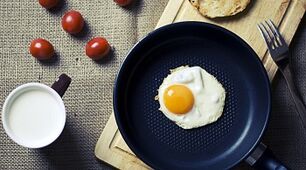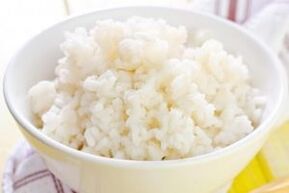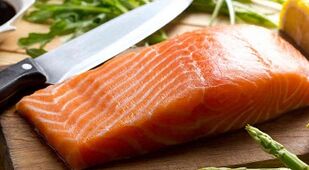
The modern pace of life does not allow most people to treat their health with sufficient attention. Additives for fast food and synthetic foods can cause stomach and digestion problems. A large number of people suffer from gastritis.
Pharmaceutical companies offer a wide variety of medications, but if the right diet for gastritis is not followed, this unpleasant disease will not regress.
Gastritis is an inflammation of the lining of the stomach. This occurs for several reasons:
- eating disorders, especially the habit of eating dry food, excessive love for spicy foods, "starving" diets;
- the presence of low quality products in the diet;
- bad habits;
- stress;
- prolonged use of certain medications;
- presence of Helicobacter pylori bacteria in the stomach.
Gastritis manifests itself quite clearly - heartburn, pain and heaviness in the abdomen, nausea, vomiting, stool disorders. It is difficult to get rid of the disease; an integrated approach is needed. A proper diet for gastritis is essential for your recovery. The choice of diet depends on the type of disease. Distinguish gastritis:
- erosive
- ; atrophic
- ;
- with an increase or decrease in stomach acidity;
- in acute and chronic form.
Diet for acute gastritis
With this disease, the gastric mucosa is inflamed, so fasting is recommended. The ideal is to abstain completely from eating and drinking on the first day, giving your digestive system rest. It is allowed to drink a little water, always lukewarm.
Cold and heat during an exacerbation are contraindicated.

So the diet should gradually include a weak broth, oat-based decoctions or rice cereal. As a drink, it is preferable to offer the patient weak tea, decoctions with rosehips and chamomile.
In some days, the acute gastritis diet can be expanded.
Recommended food:
- viscous soups;
- rice with milk, semolina, oatmeal;
- steamed omelets;
- boiled eggs; skimmed or skimmed milk;
- curd soufflé;
- drinks: unsaturated jams and jam, weak tea with lemon or honey.
After gastritis symptoms disappear, you can gradually return to your normal diet. There are several products that, even outside the period of exacerbation, are unsuitable for people with a tendency to inflammation of the gastric mucosa. Gastritis is an insidious disease, it can return at any time.
During the remission period, it is necessary to strictly limit or completely abandon spicy, fatty and fried foods, fresh fruits and vegetables, soft drinks, alcohol, coffee.
Chicory in its effect on mucous membranes is comparable to coffee, it is also better to abstain from it. This diet, after suffering acute gastritis of the stomach, will help to further reduce the risk of further attacks.
Pay attention!Milk porridge or porridge in water is a healthy breakfast dish, but avoid instant or unboiled cereals, they are not so useful and contain additives that are harmful to a weakened stomach. During periods of exacerbation of the disease, it is best to clean the porridge additionally.
Diet for chronic gastritis
The diet for chronic gastritis of the stomach allows you to eat:
- milk porridge, well cooked and sparse in consistency;
- mashed soups or mashed vegetable soups;
- hard-boiled eggs;
- steamed omelets;
- dairy products and non-acidic cottage cheese;
- meat or fish well cooked.
What sweets can you eat with chronic gastritis? The use of sugar, marshmallows, honey, various jams and jams, some types of nuts (preferably non-acidic, pre-cooked) is allowed.

It is best to use pasta or cooked rice as a side dish. White bread is allowed, but not fresh, but dry or old.
Recommended drinks include milk tea with milk, still mineral water, fruit and milk jelly.
Traditional medicine advice:Freshly squeezed potato juice helps treat gastritis. You need to drink on an empty stomach, half an hour before breakfast, outside the period of exacerbation of the disease. It is best to use new vegetables that have not accumulated harmful substances.
The list of what you can eat for gastritis is quite extensive. Products that contribute to the abundant formation of gastric juice are strictly prohibited, namely:
- fish and meat cooked in the juice itself, as well as rich broths;
- sauces, canned foods, pickled or pickled vegetables;
- fried and smoked foods;
- herbs and spices;
- sour cottage cheese; skimmed milk;
- hard-boiled eggs;
- ice cream, chocolate, halva;
- acid berries;
- strong tea or coffee, sparkling water, alcohol, any fizzy drinks.
The list of foods that can be eaten during exacerbations of chronic gastritis also limits the rough foods that irritate the stomach. These are wholemeal bread, pastries, whole grains, mushrooms, nuts, skin of birds or fish, fresh fruits and vegetables. The inflamed mucosa during the period of exacerbation of the disease accepts only mashed boiled food, as well as food products that have undergone careful mechanical processing, puree dishes.
Important!Outside the period of exacerbation of gastritis, fresh carrot juice is useful. The composition of the carrot strengthens the walls of the gastric mucosa. and helps to regulate metabolic processes. The patient needs to drink half a glass an hour before breakfast for 10 days, then take a break. But it is necessary to take it only after consulting the doctor, since the treatment with carrot juice is not indicated for patients with high acidity.
Diet for gastritis with high acidity
In this case, the diet should aim to neutralize the high acidity, that is, to reduce the concentration of hydrochloric acid in the stomach.
To do this, the patient menu includes:
- soups in a weak, non-concentrated broth;
- cooked meat of dietary varieties (eg rabbit or turkey, chicken breast);
- fish and seafood cooked from the river;
- hard-boiled eggs;
- dairy dishes and goat's milk;
- pea, zucchini after mechanical processing, preferably in the form of puree;
- dry white bread or cookies; Side dishes
- : cooked pasta, buckwheat or oats;
- drinks: sweet fruit jams and jellies, weak tea with milk.
It is recommended to eat pureed cottage cheese. You can cook the curd souffle. Outside the period of exacerbation, cheesecakes, dumplings and cottage cheese casseroles are added to the diet.
Traditional medicine advice:Sea buckthorn oil is an effective treatment for the disease. It surrounds the walls of the stomach and many people know its healing properties. Well suited to help gastritis with high acidity.
A therapeutic diet for gastritis with high acidity excludes foods that stimulate the production of gastric juice - these are salty or spicy foods, smoked and fatty foods, as well as:
- broths and borscht, sour cabbage soup;
- fresh bread;
- fermented dairy products; confectionery
- ;
- dried fruits and green fruits;
- strong tea, coffee, any fizzy drinks;
- spices and seasonings;
- Pickled or pickled vegetables and bitter.
Do not forget the mechanical principle of the treatment table: products with thick fiber are contraindicated. In the diet of a patient with gastritis, there should be no bread bran, whole grains, radishes, turnips.
Important!It is forbidden to eat fresh carrots for gastritis with high acidity. Dishes that include boiled or fried eggs are also prohibited for gastritis.
Diet for gastritis with low acidity
The diet for gastritis of the stomach, which continues with decreasing acidity and decreasing the production of gastric juice, on the contrary, aims to increase the concentration of hydrochloric acid. This diet is based on:
- viscous porridge;
- vegetable purees;
- Lean cooked meat and pasta;
- meat and fish broths;
- cutlets, sausages, lean ham;
- baked potatoes;
- dry bread;
- tomatoes, fresh herbs, cinnamon, vegetable juices;
- jam, tea and coffee;
- slightly carbonated mineral water;
- roasted fruits, mousses, fruit juices.
Smoked fish is recommended for gastritis with low acidity and it is recommended to start eating with a piece of herring. An important condition is that the salted herring must first be soaked.
Traditional medicine tip:You can induce gastric juice production before you start eating in a simple and harmless way - imagine delicious food, watch ads with watery foodsin the mouth or photos of “delicious” foods.
Restrictions on such a patient's diet are imposed on sugary drinks with gas, fatty and fried foods, fresh bread or bran, any legumes (including peas and beans soups), hard cheese, fatty fish, chocolate and sweets.
Pay attention!Patients with low stomach acid are the most attacked by Helicobacter pylori bacteria. In such an environment, residual bacteria products reduce the acidity level to a minimum.
The doctor recommends it! Apples are the healthiest food for gastritis. For gastritis with high acidity, varieties of sweeter apples are chosen, and apples with acidity are suitable only with low acidity. As the disease worsens, apples are subjected to mechanical processing - they are cleaned or crushed.
Diet for atrophic gastritis
Atrophic gastritis is characterized by an insufficient amount of digestive enzymes. The incoming food is not completely decomposed and absorbed. A list of what you can eat with this type of gastritis:

- low-fat cooked meat and fish;
- meat or fish soups with vegetables and cereals;
- sweet fruits and berries;
- vegetables;
- non-acidic dairy products;
- mineral water, jam, weak tea and cocoa.
Eggs for atrophic gastritis are allowed in boiled form or cooked in a steamed omelet.
Prohibited foods include fatty fish, mushroom broths, fatty meats and rich meats, berries and sour fruits, soft drinks, chocolate, cakes, muffins and canned foods.
Diet for erosive gastritis
Erosive gastritis is accompanied by the presence of small erosions on the walls of the stomach - defects of the mucous membrane. The therapeutic diet for erosive gastritis includes surrounding foods and foods that mechanically spare the injured mucosa:
- liquid soups, preferably viscous in consistency;
- dietary meats;
- steam chops;
- non-acidic dairy products;
- folder;
- vegetable dishes;
- butter, cream, milk-based sauces;
- Sweets: jam, honey, marshmallow, marshmallow, sweet fruit compotes and jams;
- drinks: jam, jam, weak tea.
Rice for erosive gastritis will be an ideal option for breakfast if cooked in the form of mashed porridge.
You should avoid eating traumatic and aggressive foods, namely: fatty and smoked foods, dishes of mushrooms, vegetables, canned, savory, spicy, sour fruits and fruits, raw or pickled vegetables, fresh bread and sweets, natural juices, strong drinks, alcohol.
Eating oily and smoked fish is not recommended for erosive gastritis.
General nutrition advice for gastritis
- Meals are better organized frequently (5-6 times a day) and regularly, observing the diet. Your schedule should include:
- first breakfast,
- lunch,
- lunch,
- afternoon tea,
- dinner.
- Eat in small portions, about 300 grams per meal. Avoid eating too much and have breakfast at specific times. Doctor advises! Try not to eat liquid and solid foods at the same time, differentiate between them.
- Avoid temperature spikes in food intake - an upset stomach accepts food comfortably only when it is hot.
- Simplify your menu. The fewer meals a day in the diet, the easier it will be to deal with stomach stress.
- After each meal, you need to rest for 20 minutes, minimum physical activity.
- The diet should contain all important vitamins and minerals, as well as a balanced amount of protein, fats and carbohydrates. Eat sweet baked fruits, jams, jams and juices every day according to your list of allowed foods.
- During the period of exacerbation, the diet should include sufficiently digestible proteins, drink at least a glass of milk.
- Don't drink food with water! You can drink 15-20 minutes after eating. Otherwise, defective enzymes and gastric juice will be diluted with water.
- Dishes eaten for gastritis should not irritate the stomach, so it is necessary to eat viscous cereals, puree and soups every day. Food needs to be adapted as much as possible for stomach pain, so if it is not sufficiently liquid or dried, mechanical processing should be done immediately during the meal, that is, chew each piece well.
- Rice broth and porridge for gastritis is not only a suitable type of food, but also an effective way to obtain nutrients and remove toxins. Great option for breakfast.Important!For nutrition of patients with gastritis, it is best to dip the rice in water before cooking.
Gastritis is difficult to treat. Only complex therapy, including taking medications prescribed by the doctor and strict adherence to a carefully selected diet, will allow you to get rid of unpleasant symptoms and avoid the consequences of gastritis, such as stomach ulcer.































































